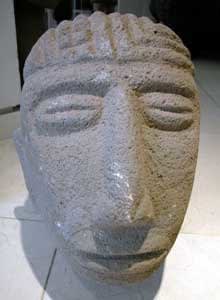Basalt Trophy Head, 500 CE - 1000 CE
Basalt
10 x 12.5 x 11
PF.4608
The pleasure of seeing oneself depicted in art, either in painting, sculpture or in photographs, is one of the great joys of life. Few people can afford the first two...
The pleasure of seeing oneself depicted in art, either in painting, sculpture or in photographs, is one of the great joys of life. Few people can afford the first two representations; and in ancient cultures only the wealthy and powerful elite could pay for the expert skills needed for a "portrait" in stone. This very elegant head required not only great sculptural skills, but the justification and reason why it should be made in the first place. To discover this reason we must look at the society in which it was created and the people for whom it was made. In ancient Costa Rica the nobles held authoritarian control, and fought the frequent battles in order to maintain dominance and to acquire captives for ritual sacrifice. This very powerful head may be an enlarged version of a shrunken trophy head of a defeated enemy. Such sculptures were reminders of past victories and served to continue the reputation of those who won the battles. However, the dignity and alertness of expression suggests a living model was used, perhaps the actual features of a prominent warrior/ nobleman. The very beautiful coiffure further encourage the belief this head represented someone of importance. Just like the Pharaohs of Egypt, the Costa Rican nobility may have wished to perpetuate their image through the ages- and in this particular example one nobleman has succeeded in acquiring immortality.



